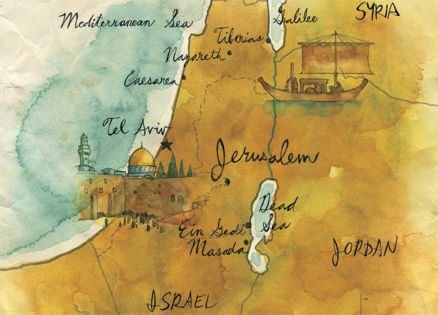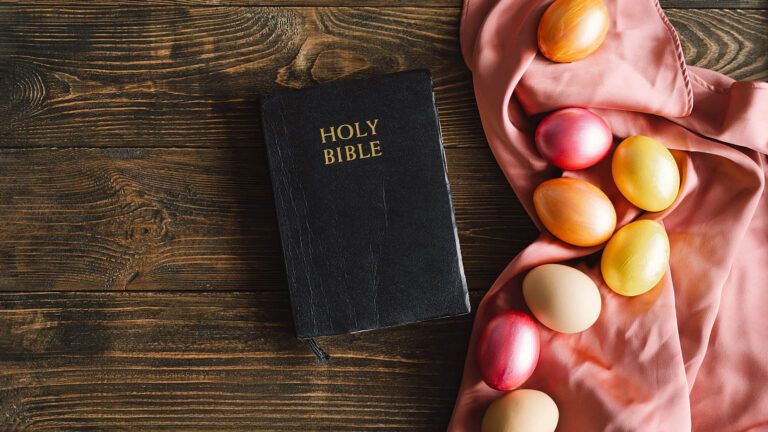NAZARETH
It’s an awesome feeling to be in Israel, a place where it’s hard to walk anywhere a prophet, savior or other biblical hero hasn’t walked before.
Like the city of Nazareth, where I found myself on the first day of my weeklong tour through the Christian religious and historical sites of the Holy Land, hosted by the Israel Ministry of Tourism. It was my third time to Israel—I first went when I was 14 with my family—but every time offers new and enriching experiences. This trip would be no exception.
I’d imagined Nazareth would look like it did in the movie The Nativity Story, which we featured in Guideposts a few Christmases ago. But that Nazareth was nowhere to be seen among the apartment buildings topped with satellite dishes.
Then we drove up a hill overlooking the city, and arrived at Nazareth Village, a first-century hamlet recreated by biblical scholars. Here, a woman dressed in a Roman-era tunic—fittingly named Mary—cooked us a traditional lunch over an open fire: pita bread and lentil soup, with salads, apples, dates and honey—fruits of the area’s farms.
Our guide to the village demonstrated an olive-oil press, explaining how the first few drops of oil produced are called extra virgin. To Jews of the first century, our guide said, it was holy. Sweeter than the rest of the oil, it was reserved for anointing the high priests. It didn’t smoke when burned, so it was used to power the eternal flame kept lit in the temple.
I’m Jewish, and I never knew that.
Sitting in the synagogue, recreated to the last detail, including a roof built of mud and straw, I imagined myself back in time. My fellow tourists, listening to our guide, became the people of Nazareth, learning from our “rabbi.” The modern city faded away.
GALILEE
I woke up the next day in a haze. Overnight, a white cloud had settled over Tiberias—a city on the west shore of the Sea of Galilee and our base for exploring the area.
The region’s gorgeous views were obscured. But as we sailed around the Sea of Galilee in our charter boat, one member of our group, Bonnie, gave a devotional reading that put things in perspective. “Even though the sun is out of view, it is still there,” she said. “And so it is with God.”
The crew raised an American flag alongside an Israeli one to welcome us. Then the music started. The captain and his first mate sang traditional Jewish folk songs and led us in a spirited hora, a circle dance not normally performed on rocking boats. I know the hora well: It’s the typical dance at Jewish weddings and bar and bat mitzvahs (a Jewish rite of passage). But sharing it with people who had never danced it before gave me a thrill.
Back on the road again, I could finally see the beauty of this region. I gazed out the bus window at the lush green valleys and rolling hills, the date palms and mango trees, greenhouses and grazing cows.
On top of the Mount of the Beatitudes, where Jesus gave his famous sermon, we sat in a garden filled with chirping birds and colorful flowers, listening to our group organizer recite Jesus’ words, “Blessed are the meek, for they will inherit the earth.” The hazy sky made it easier to block out anything modern in the valley and imagine it as it was so many centuries ago.
THE DEAD SEA
We drove down south the next morning through the Jordan Valley toward the Dead Sea. I watched the farms and greenhouses slowly disappear, the green hills become rocky, barren cliffs.
To the east, in the distance, the large salty sea sparkled, teasing thirsty travelers with undrinkable water. Today, spas line its shores. We stopped at one to see what makes this barren spot of desert such a popular destination. Well, this spa used to be on shore. The sea level had dropped so much over the years, the shore was now a blazingly hot 10-minute walk through mud and salt flats.
Finally, I stepped into the water. The salt gave it a silky feeling against my skin. I got to about waist deep and it became harder to put my feet down. Then, suddenly, they rose from under me. I was sitting, practically upright, in water! The whole group had fun trying to force limbs back underwater, playing around with this rare creation.
Floating wasn’t all that made the water magical. Minerals in the water and mud have been found to possess unique healing properties. We dried off and hit the gift shop to buy some mineral-infused soaps to take home. How amazing that a “dead” sea could be full of life-enhancing materials. Only in the Holy Land.
THE OLD CITY
“Here in Jerusalem, every stone tells a story,” our Israeli tour guide, Rivka, told us our first morning in the holiest of cities.
I’d been here before, but there were stones whose stories I hadn’t heard. Like the front stairs of the Temple Mount. The steps were massive, designed with different lengths to slow the congregation’s ascent. Alongside them we saw a road lined with stalls where Jews may have purchased the animals for the ritualistic sacrifices.
Closing my eyes, I could picture the surreal scene: a procession of believers with their sacrificial animals marching up toward the temple towering above the city. It must have been an awe-inspiring sight.
But for me, now, the awe-inspiring sight was the Kotel, the Western Wall. An orthodox Jew helped me put on tefillin (small boxes filled with Scripture and strapped to the arm and the head). I followed tradition and tucked prayers I had written for family and friends into the cracks in the wall. The wall is the closest place Jews of today can get to the original site of the Holy Temple, the place where it is believed God first created the earth, the place where he spared Abraham’s son Isaac.
At least I thought it was the closest. Again, I heard new stones speak. Recent excavations revealed the full extent of the Western Wall. We descended into a tunnel far below ground to the street level of the first-century city. I ran my hand against stones closer to the holiest spot in Judaism, stones that lay buried for nearly 2,000 years. This tunnel wasn’t here on my first visit to Israel. What new stones would I find on my next trip?
YAD VASHEM
There is a wound in a mountain overlooking Jerusalem, cut by a blade of concrete and glass. I saw it on our second to last day: the main building of Israel’s Yad Vashem Holocaust memorial.
Walking inside, I thought about my late grandpa Morey, who fought in World War II with the Fifth U.S. Army, the unit that liberated the Dachau death camp. My grandpa spoke very little about the war, and even less about what he saw at the camp. He was with me when I first visited Israel, but this version of Yad Vashem had yet to be built. I wondered how it would have affected him. I couldn’t keep tears out of my eyes.
I saw family photographs victims brought with them to the camps, a pair of glasses a survivor kept for years, the only remains of her mother. I stepped on cobblestones from the Warsaw ghetto, while hearing survivors describe the desperation and suffering the Nazis and their collaborators inflicted upon them.
Then I saw my grandpa, or believed I did. The image flashed by on the screen quickly, photos of American soldiers at the Dachau camp, staring horrified at the atrocity in front of them. The look I saw on that soldier’s face told me so much about Grandpa’s silence about the war. I’d expected this trip to fill some gaps in my knowledge of history. But now, in a stunning way, a gap was filled in my own family’s past.
THE LAST DAY
My final day in Israel came too soon. I vowed to spend every moment absorbing each detail. Overpowering everything was the song.
It began on the Mount of Olives, on the lower part of the slope known as the Garden of Gethsemane. On the busy street outside the garden walls, vendors hawked souvenirs, but our guide led us into a private garden, an oasis of quiet threaded by gravel walkways and shaded by olive trees. In this tranquil setting, members of our group started to sing “I Come to the Garden Alone.”
The singing continued at the Church of St. Peter in Gallicantu, built atop remains of the palace of Caiaphas, where Jesus was held prisoner. The group in front of us sat in the darkness
of a cell where Jesus may have been tortured, voices harmonizing in the hymn “By His Stripes We Are Healed.”
In an alleyway of the Muslim Quarter, the song changed key. Young Arab children, leaving their madrassa for the day, ran by shouting, “Allahu Akbar,” meaning “God is Great.”
Inside the Church of the Holy Sepulchre, sounds of competing services and rituals overlapped. In one section, a long-bearded priest’s hymn soared to the rafters. In another, deacons in vestments shook incense-burning censers by long chains, releasing white puffs of fragrant smoke into the air. Chants in Latin and Greek echoed from the gilded domes overhead while those lighting candles whispered prayers. Altar boys cut through the crowd, pounding staffs into the ground as they marched. A “status quo” strictly divides the church among different Christian denominations, but their voices came together nonetheless.
For seven days, I’d seen the beauty of Israel, marveled at its power, been moved by its story. There’s so much history here it’s no wonder people fight over this place, but I left with a hopeful view. What other country inspires so many nations and religions to sing? I can’t wait to hear the song again.
See video from Adam Hunter’s trip to Israel!






